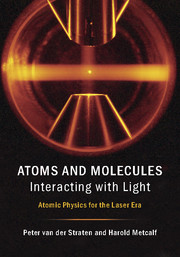Book contents
- Frontmatter
- Contents
- Preface
- Part I Atom–light interaction
- 1 The classical physics pathway
- 2 Interaction of two-level atoms and light
- 3 The atom–light interaction
- 4 “Forbidden” transitions
- 5 Spontaneous emission
- 6 The density matrix
- Part II Internal structure
- Part III Applications
- Part IV Appendix
- References
- Index
1 - The classical physics pathway
from Part I - Atom–light interaction
Published online by Cambridge University Press: 05 February 2016
- Frontmatter
- Contents
- Preface
- Part I Atom–light interaction
- 1 The classical physics pathway
- 2 Interaction of two-level atoms and light
- 3 The atom–light interaction
- 4 “Forbidden” transitions
- 5 Spontaneous emission
- 6 The density matrix
- Part II Internal structure
- Part III Applications
- Part IV Appendix
- References
- Index
Summary
Introduction
While it might appear that the nineteenth-century physics presented in this chapter has no place in a topic as quantum mechanically oriented as atomic physics, this is simply not the case. The purpose of this first chapter is to try to convince the readers that the material learned in their early years of studying physics is not disjoint from modern topics, but in fact can provide a foundation for their further understanding. Other examples will occur later.
The reader may be a bit surprised to see that the results of the classical description turn out to be so close to the quantum mechanical results. Where there are significant disagreements between classical and quantum descriptions, it is necessary to explain why these occur. The correspondence principle requires that in the limit of large quantum numbers the complete quantum mechanical description must agree with the classical one. It is always better to need fewer of these explanations and to be able to treat physics as a coherent whole instead of a collection of topics.
The consequences of classical physics are intuitively familiar, and this is often most helpful in gaining deeper understanding. In fact, the approach taken in very many of the chapters in this book is to start with a purely classical description of a topic, and then transport it directly into the Schrödinger equation. Radiation from an accelerated charge, as treated here in the harmonic case, provides an ideal setting for such pedagogy. Even though classical mechanics is used in place of quantum mechanics, for the case of harmonic motion, the results are quite compatible.
The early history of atomic physics contains many topics that are well worth reading about, especially the experimental facilities. For example, there were no electric motors, wire was not readily available, and making even a crude vacuum was an experimental tour de force. Very many textbooks have discussions of these topics, and so they will not be presented here. But the reader is warned that certain oft-repeated modern descriptions are simply wrong.
Perhaps the most important notion to be gained from this chapter is that the classical description of a harmonically bound electron provides quite accurate results about the interaction between atoms and light. Of course, the utility of this description is limited because the classical harmonic oscillator has no internal structure, is infinitely deep, and has a continuous energy spectrum.
- Type
- Chapter
- Information
- Atoms and Molecules Interacting with LightAtomic Physics for the Laser Era, pp. 3 - 15Publisher: Cambridge University PressPrint publication year: 2016



